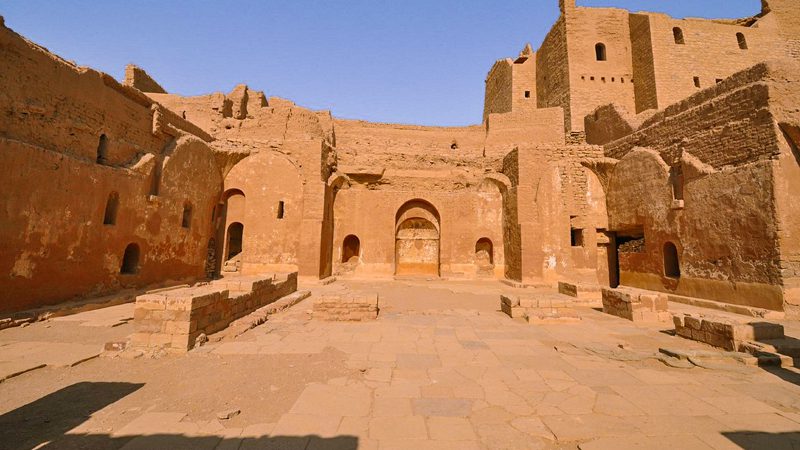Nestled on the banks of the majestic Nile River, the Monastery of St. Simeon stands as a testament to the rich spiritual heritage and architectural marvels of Aswan City. This ancient monastery, also known as the Anba Hate Monastery, holds a significant place in the history of Christianity in Egypt. In this article, we will embark on a journey to explore the captivating history, awe-inspiring architecture, and spiritual significance of the Monastery of St. Simeon.


Origins and Purpose
The Monastery of St. Simeon was constructed in the 7th century during the Coptic era, dedicated to St. Simeon the Stylite, a renowned ascetic saint. The monastery served as a place of worship and a refuge for monks seeking solitude and spiritual contemplation. Its remote location on the outskirts of Aswan allowed for a secluded and peaceful environment away from the distractions of the city.
Abandonment and Rediscovery
Over the centuries, the Monastery of St. Simeon fell into disuse and was eventually abandoned in the 13th century. It remained hidden and forgotten for many years, covered by desert sands. It was not until the 20th century that the monastery was rediscovered and underwent restoration to preserve its historical and cultural significance.
Majestic Ruins
The Monastery of St. Simeon showcases remarkable architectural remnants transporting visitors back in time. The ruins reveal the grandeur of the past, with towering walls, intricate stone carvings, and remnants of once-elaborate structures. The intricate craftsmanship and attention to detail are evident in the ornate decorations and religious motifs that adorn the walls.
Basilica and Ancillary Buildings
The monastery complex consists of various buildings, including the main basilica, monk cells, refectory, and chapels. The basilica, with its towering walls and majestic arches, served as the central place of worship. The ancillary buildings provided living quarters for the monks, communal spaces, and facilities for daily activities. Exploring these structures offers a glimpse into the lives of the devoted monks who resided there centuries ago.
A Place of Worship and Contemplation
The Monastery of St. Simeon holds deep spiritual significance for the Coptic Christian community. It served as a sanctuary for monks who sought solitude, prayer, and communion with God. The peaceful ambiance of the monastery, surrounded by the natural beauty of the Nile River and the desert landscape, creates an atmosphere conducive to reflection and spiritual contemplation.
Religious Festivals and Pilgrimages
The monastery remains an active religious site, attracting Coptic Christians and visitors worldwide, particularly during religious festivals and pilgrimages. These occasions provide opportunities for worshippers to gather, celebrate their faith, and pay homage to the legacy of St. Simeon and the monastic tradition.
Frequently Asked Questions (FAQs)
How can I reach the Monastery of St. Simeon?
The Monastery of St. Simeon is located on the west bank of the Nile River, near Aswan City. It can be accessed by a short boat ride or a felucca excursion from Aswan. Local tour operators often organize guided tours to the monastery, providing transportation and insightful information about its history.
Is there an entry fee to visit the Monastery of St. Simeon?
There is an entry fee to visit the Monastery of St. Simeon. The fee contributes to the maintenance and preservation of the site, ensuring its cultural and historical heritage is protected for future generations.
Are there any restrictions on photography inside the monastery?
While photography is generally allowed in the monastery complex, being respectful and mindful of the surroundings is advised. Some areas or specific religious artifacts may have restrictions on photography, so it’s recommended to inquire locally or follow the guidance of the monastery staff.
Is there a dress code to be followed when visiting the monastery?
As the Monastery of St. Simeon is a religious site, it is advisable to dress modestly and respectfully. Both men and women should ensure their clothing covers their shoulders and knees out of respect for the sacredness of the place.
Conclusion
The Monastery of St. Simeon stands as a captivating testament to the rich spiritual and architectural heritage of Aswan City. Its ancient ruins and sacred atmosphere transport visitors to a bygone era, offering a glimpse into the lives of devout monks and the spiritual devotion that characterized the Coptic Christian tradition. A visit to this historical site is not only a journey through time but also an opportunity for spiritual contemplation and appreciation of the enduring legacy of St. Simeon and the monastic tradition.
